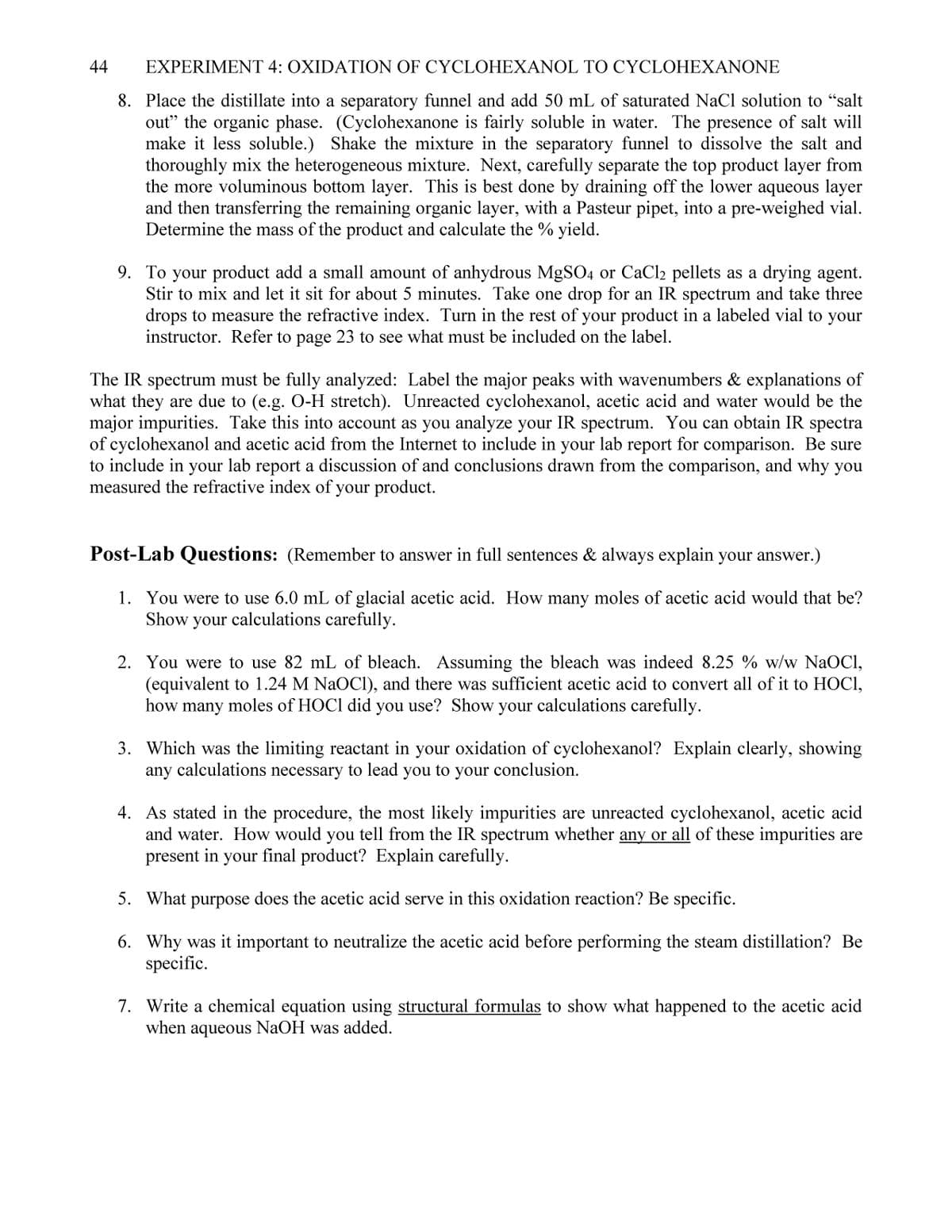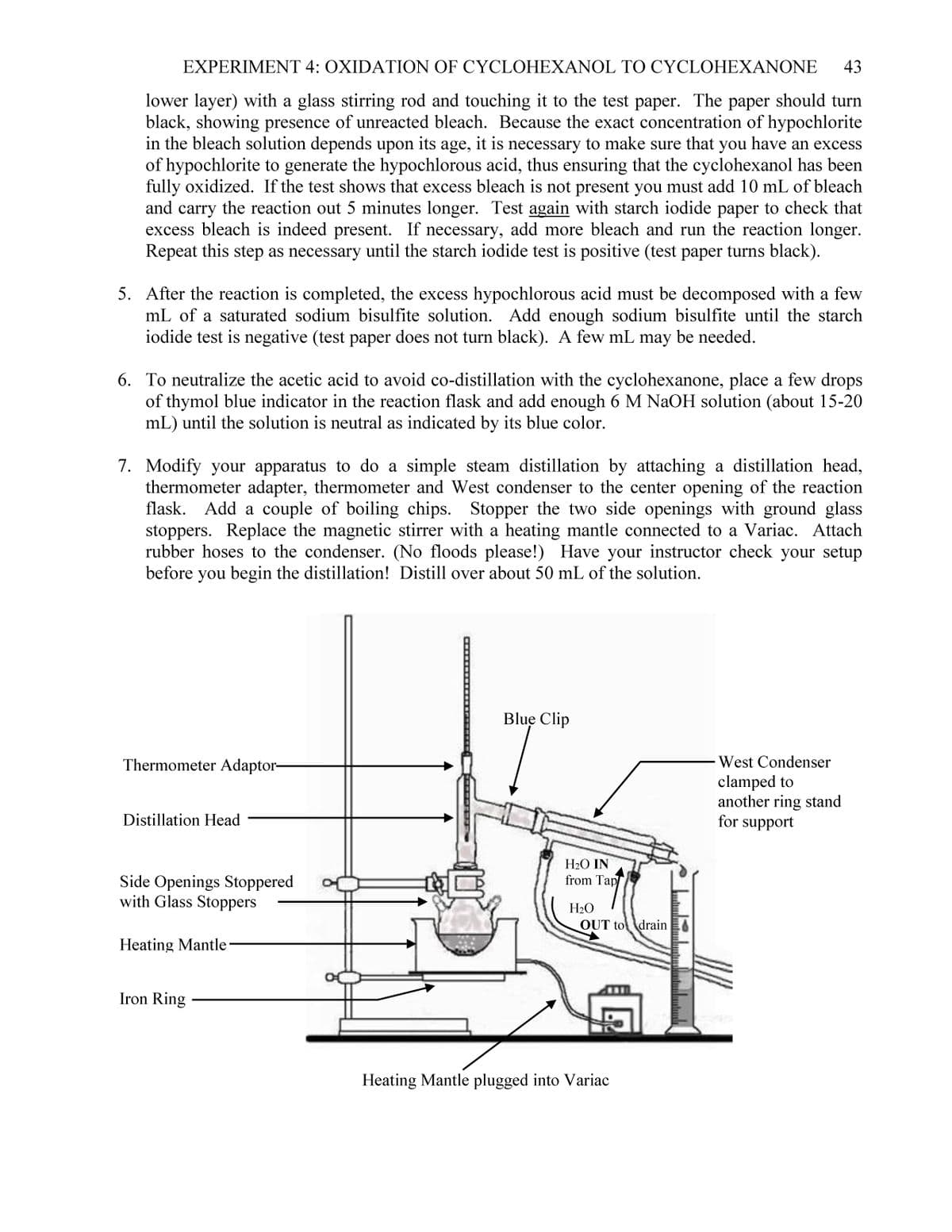Please, I need help to calculate the %yield of this experiment. These is my values obtained in the laboratory : volume of cyclohexanol = 7.39mL ; mass of cyclohexanol = 7.112 g mass of cyclohexanone obtained = 1.535 g Thymol blue = 3 drops volume of Sodium Bisulfite = 1mL volume NaOH used = 20mL
Please, I need help to calculate the %yield of this experiment. These is my values obtained in the laboratory : volume of cyclohexanol = 7.39mL ; mass of cyclohexanol = 7.112 g mass of cyclohexanone obtained = 1.535 g Thymol blue = 3 drops volume of Sodium Bisulfite = 1mL volume NaOH used = 20mL
Chapter8: Acetylsalicylic Acid
Section: Chapter Questions
Problem 6Q
Related questions
Question
Please, I need help to calculate the %yield of this experiment.
These is my values obtained in the laboratory :
volume of cyclohexanol = 7.39mL ; mass of cyclohexanol = 7.112 g
mass of cyclohexanone obtained = 1.535 g
Thymol blue = 3 drops
volume of Sodium Bisulfite = 1mL
volume NaOH used = 20mL

Transcribed Image Text:44
EXPERIMENT 4: OXIDATION OF CYCLOHEXANOL TO CYCLOHEXANONE
8.
Place the distillate into a separatory funnel and add 50 mL of saturated NaCl solution to “salt
out" the organic phase. (Cyclohexanone is fairly soluble in water. The presence of salt will
make it less soluble.) Shake the mixture in the separatory funnel to dissolve the salt and
thoroughly mix the heterogeneous mixture. Next, carefully separate the top product layer from
the more voluminous bottom layer. This is best done by draining off the lower aqueous layer
and then transferring the remaining organic layer, with a Pasteur pipet, into a pre-weighed vial.
Determine the mass of the product and calculate the % yield.
9. To your product add a small amount of anhydrous MgSO4 or CaCl2 pellets as a drying agent.
Stir to mix and let it sit for about 5 minutes. Take one drop for an IR spectrum and take three
drops to measure the refractive index. Turn in the rest of your product in a labeled vial to your
instructor. Refer to page 23 to see what must be included on the label.
The IR spectrum must be fully analyzed: Label the major peaks with wavenumbers & explanations of
what they are due to (e.g. O-H stretch). Unreacted cyclohexanol, acetic acid and water would be the
major impurities. Take this into account as you analyze your IR spectrum. You can obtain IR spectra
of cyclohexanol and acetic acid from the Internet to include in your lab report for comparison. Be sure
to include in your lab report a discussion of and conclusions drawn from the comparison, and why you
measured the refractive index of your product.
Post-Lab Questions: (Remember to answer in full sentences & always explain your answer.)
1. You were to use 6.0 mL of glacial acetic acid. How many moles of acetic acid would that be?
Show your calculations carefully.
2. You were to use 82 mL of bleach. Assuming the bleach was indeed 8.25 % w/w NaOCI,
(equivalent to 1.24 M NaOC1), and there was sufficient acetic acid to convert all of it to HOCI,
how many moles of HOCI did you use? Show your calculations carefully.
3. Which was the limiting reactant in your oxidation of cyclohexanol? Explain clearly, showing
any calculations necessary to lead you to your conclusion.
4. As stated in the procedure, the most likely impurities are unreacted cyclohexanol, acetic acid
and water. How would you tell from the IR spectrum whether any or all of these impurities are
present in your final product? Explain carefully.
5. What purpose does the acetic acid serve in this oxidation reaction? Be specific.
6. Why was it important to neutralize the acetic acid before performing the steam distillation? Be
specific.
7. Write a chemical equation using structural formulas to show what happened to the acetic acid
when aqueous NaOH was added.

Transcribed Image Text:EXPERIMENT 4: OXIDATION OF CYCLOHEXANOL TO CYCLOHEXANONE 43
lower layer) with a glass stirring rod and touching it to the test paper. The paper should turn
black, showing presence of unreacted bleach. Because the exact concentration of hypochlorite
in the bleach solution depends upon its age, it is necessary to make sure that you have an excess
of hypochlorite to generate the hypochlorous acid, thus ensuring that the cyclohexanol has been
fully oxidized. If the test shows that excess bleach is not present you must add 10 mL of bleach
and carry the reaction out 5 minutes longer. Test again with starch iodide paper to check that
excess bleach is indeed present. If necessary, add more bleach and run the reaction longer.
Repeat this step as necessary until the starch iodide test is positive (test paper turns black).
5. After the reaction is completed, the excess hypochlorous acid must be decomposed with a few
mL of a saturated sodium bisulfite solution. Add enough sodium bisulfite until the starch
iodide test is negative (test paper does not turn black). A few mL may be needed.
6. To neutralize the acetic acid to avoid co-distillation with the cyclohexanone, place a few drops
of thymol blue indicator in the reaction flask and add enough 6 M NaOH solution (about 15-20
mL) until the solution is neutral as indicated by its blue color.
7. Modify your apparatus to do a simple steam distillation by attaching a distillation head,
thermometer adapter, thermometer and West condenser to the center opening of the reaction
flask. Add a couple of boiling chips. Stopper the two side openings with ground glass
stoppers. Replace the magnetic stirrer with a heating mantle connected to a Variac. Attach
rubber hoses to the condenser. (No floods please!) Have your instructor check your setup
before you begin the distillation! Distill over about 50 mL of the solution.
Thermometer Adaptor-
Distillation Head
Side Openings Stoppered
with Glass Stoppers
Heating Mantle
Iron Ring
Blue Clip
H₂O IN
from Tap/
H₂O
OUT to drain
Heating Mantle plugged into Variac
s
West Condenser
clamped to
another ring stand
for support
Expert Solution
This question has been solved!
Explore an expertly crafted, step-by-step solution for a thorough understanding of key concepts.
Step by step
Solved in 3 steps

Knowledge Booster
Learn more about
Need a deep-dive on the concept behind this application? Look no further. Learn more about this topic, chemistry and related others by exploring similar questions and additional content below.Recommended textbooks for you

EBK A SMALL SCALE APPROACH TO ORGANIC L
Chemistry
ISBN:
9781305446021
Author:
Lampman
Publisher:
CENGAGE LEARNING - CONSIGNMENT

Chemical Principles in the Laboratory
Chemistry
ISBN:
9781305264434
Author:
Emil Slowinski, Wayne C. Wolsey, Robert Rossi
Publisher:
Brooks Cole

Macroscale and Microscale Organic Experiments
Chemistry
ISBN:
9781305577190
Author:
Kenneth L. Williamson, Katherine M. Masters
Publisher:
Brooks Cole

EBK A SMALL SCALE APPROACH TO ORGANIC L
Chemistry
ISBN:
9781305446021
Author:
Lampman
Publisher:
CENGAGE LEARNING - CONSIGNMENT

Chemical Principles in the Laboratory
Chemistry
ISBN:
9781305264434
Author:
Emil Slowinski, Wayne C. Wolsey, Robert Rossi
Publisher:
Brooks Cole

Macroscale and Microscale Organic Experiments
Chemistry
ISBN:
9781305577190
Author:
Kenneth L. Williamson, Katherine M. Masters
Publisher:
Brooks Cole